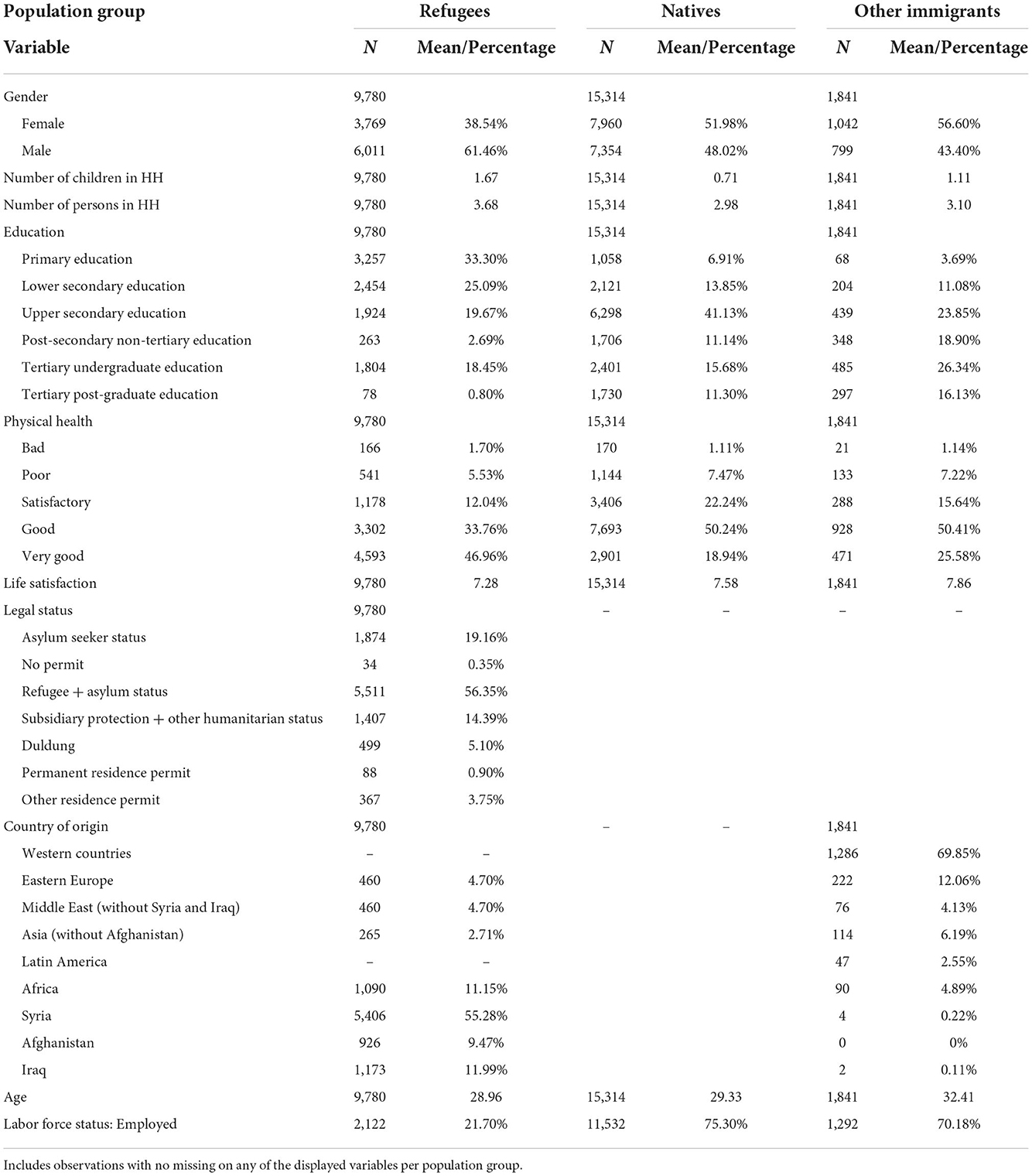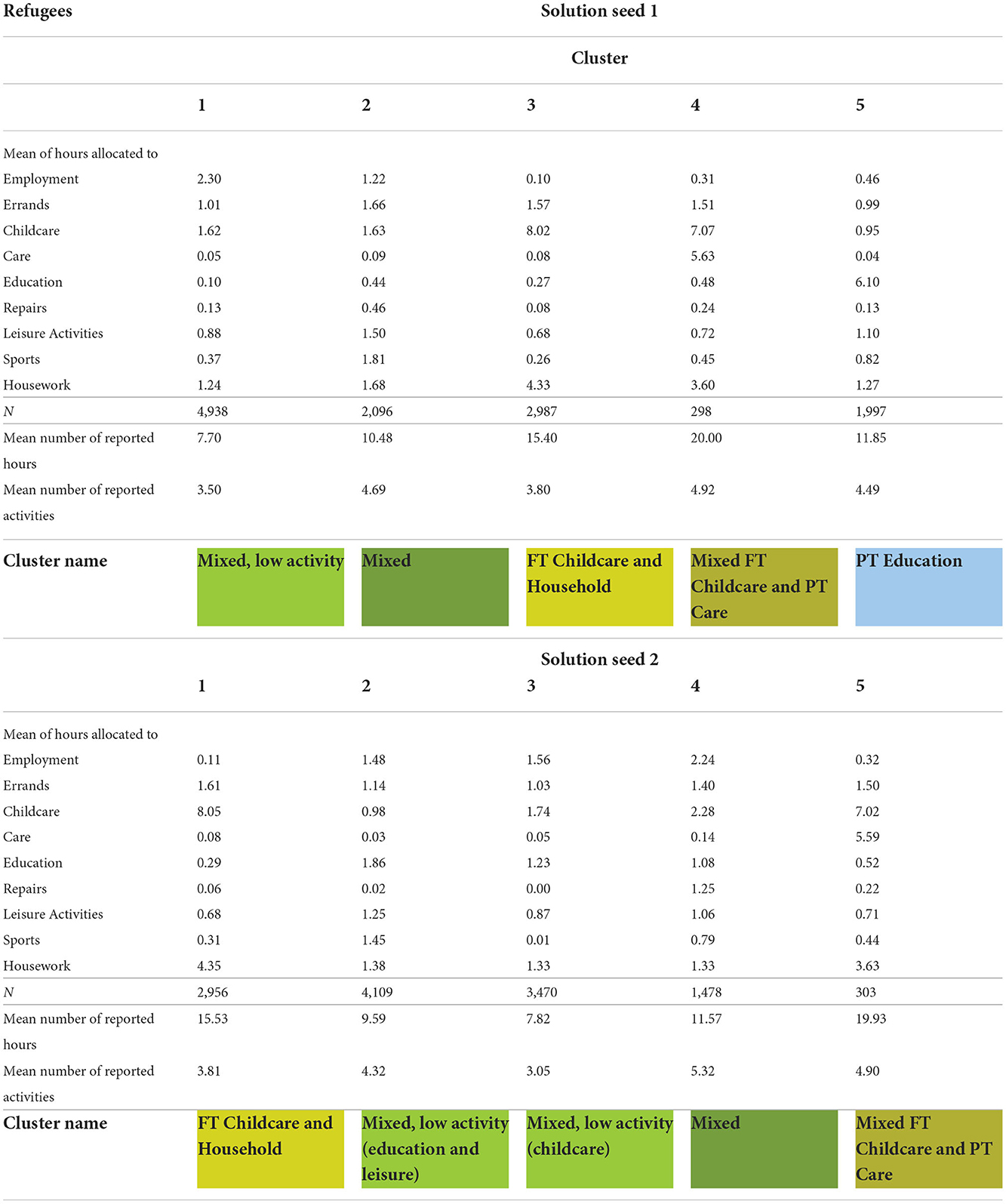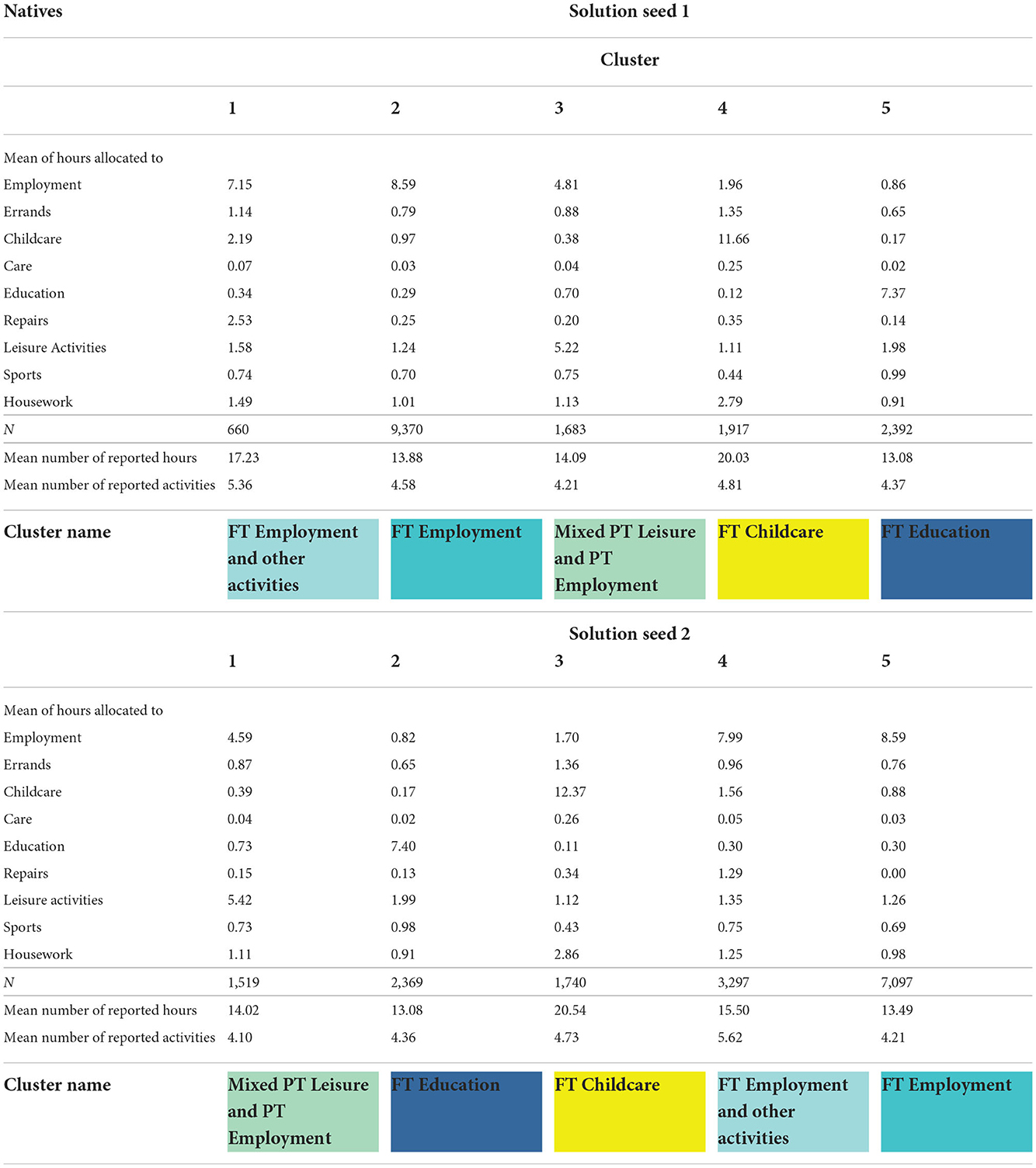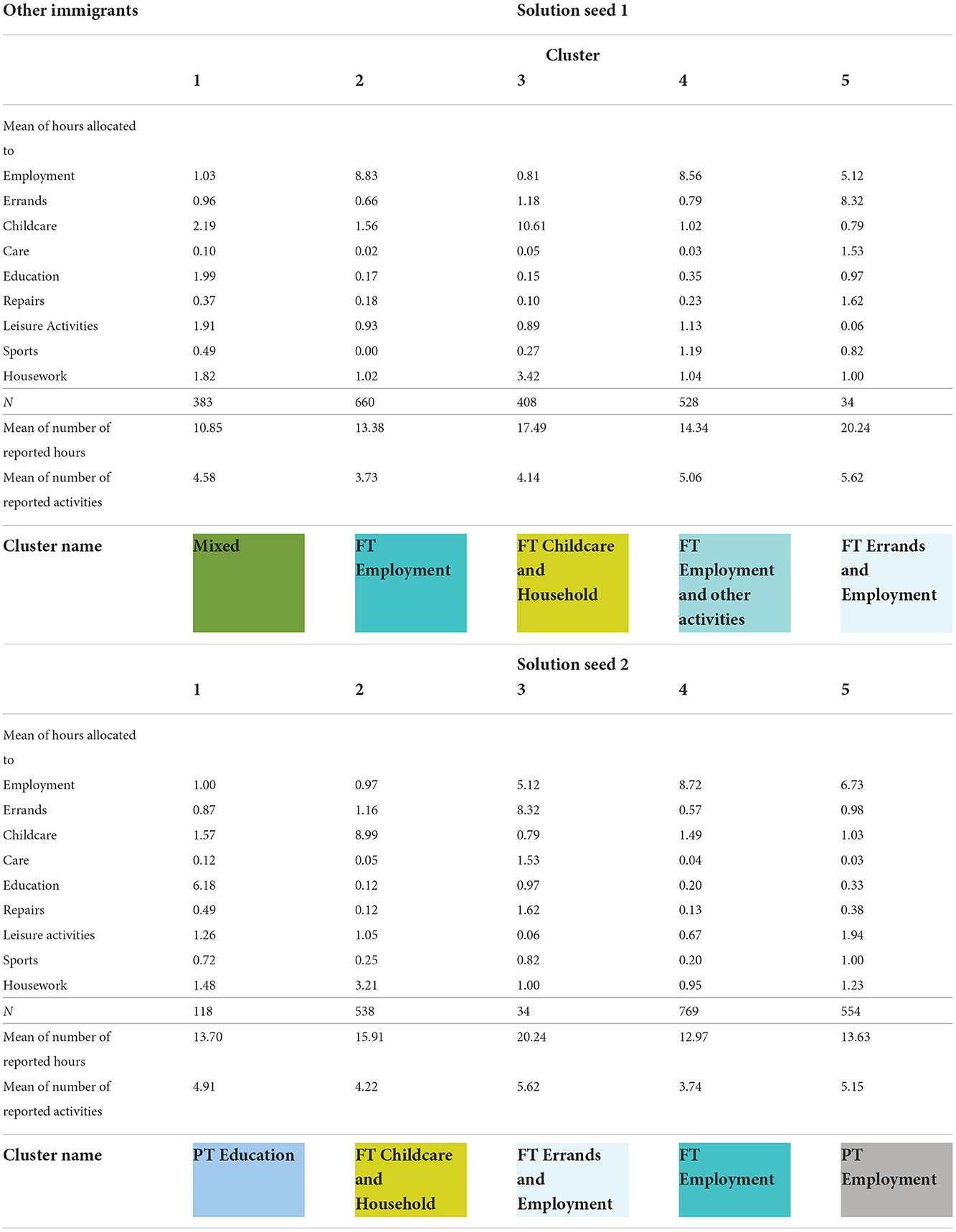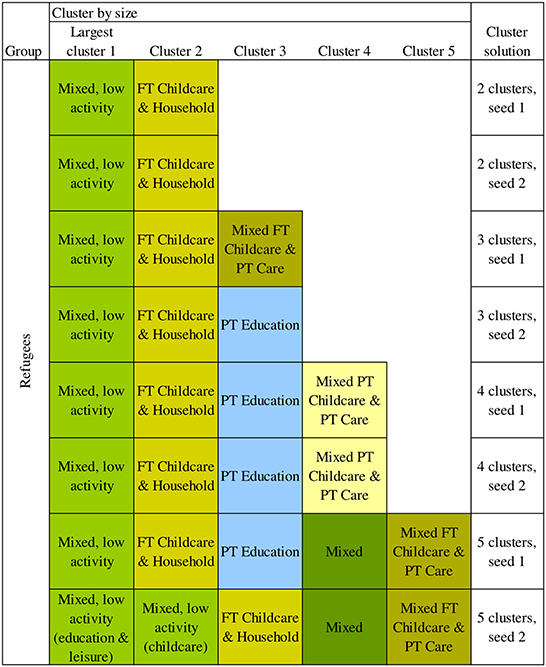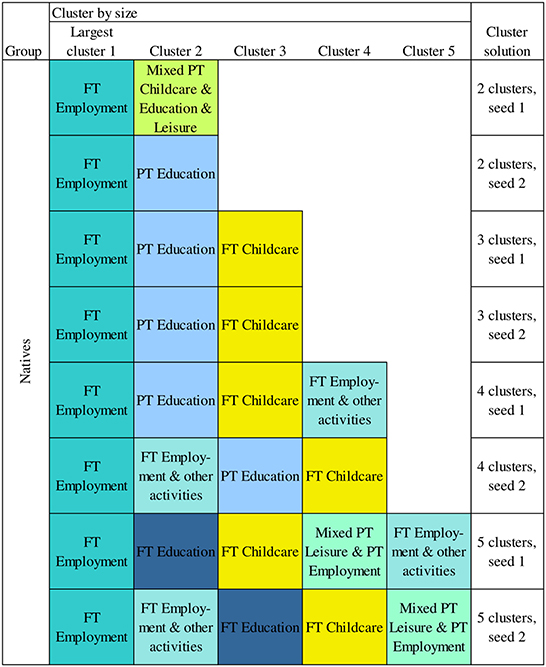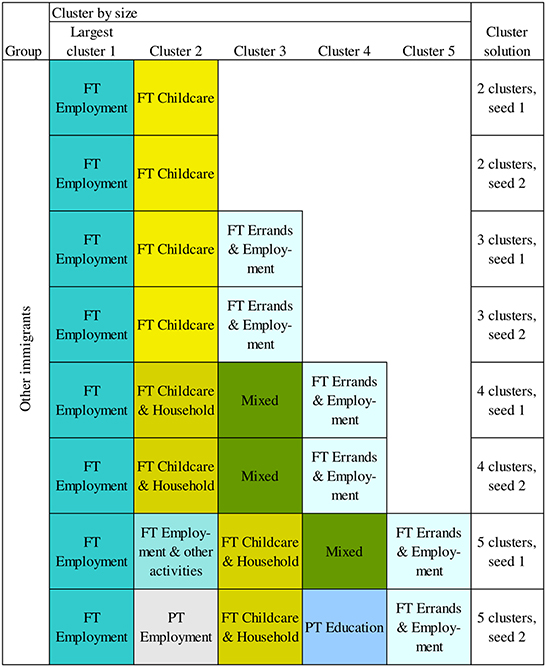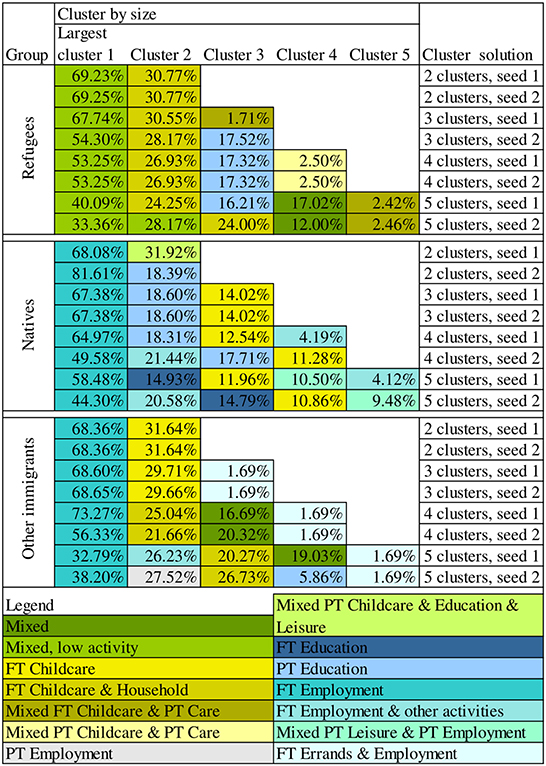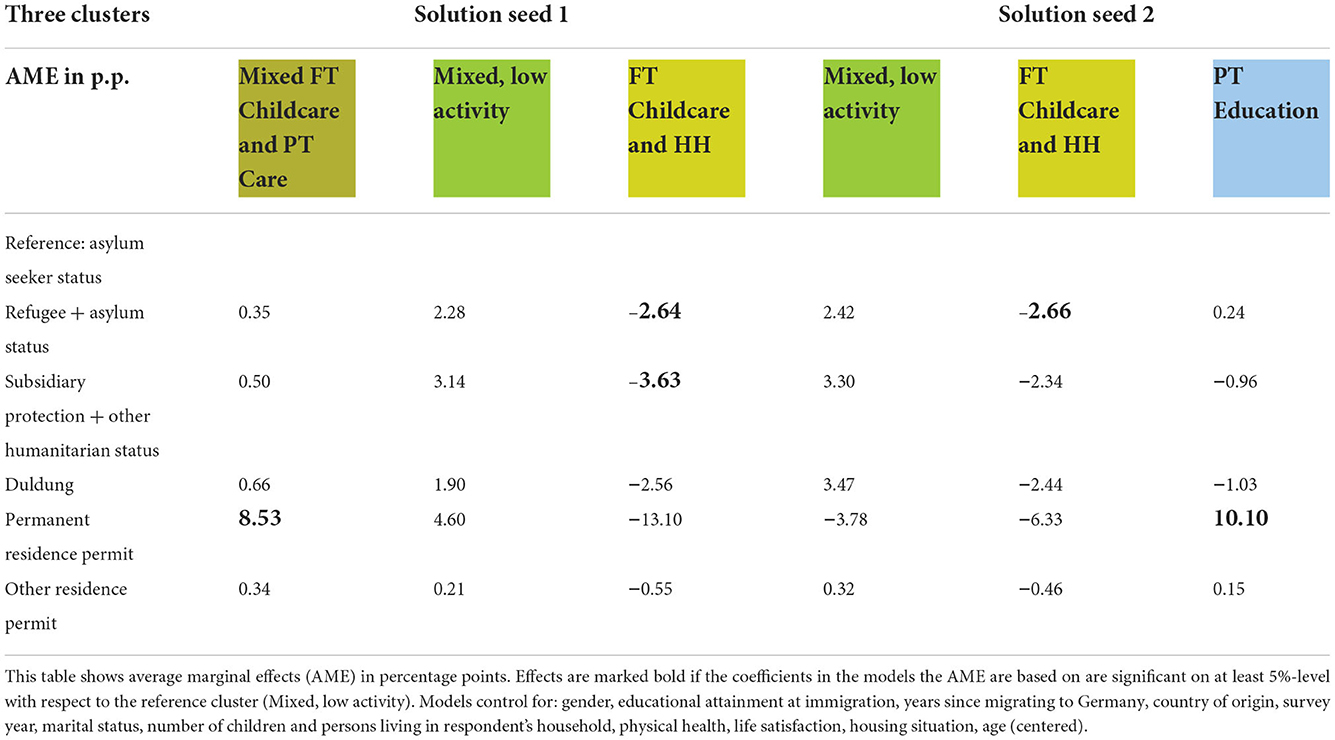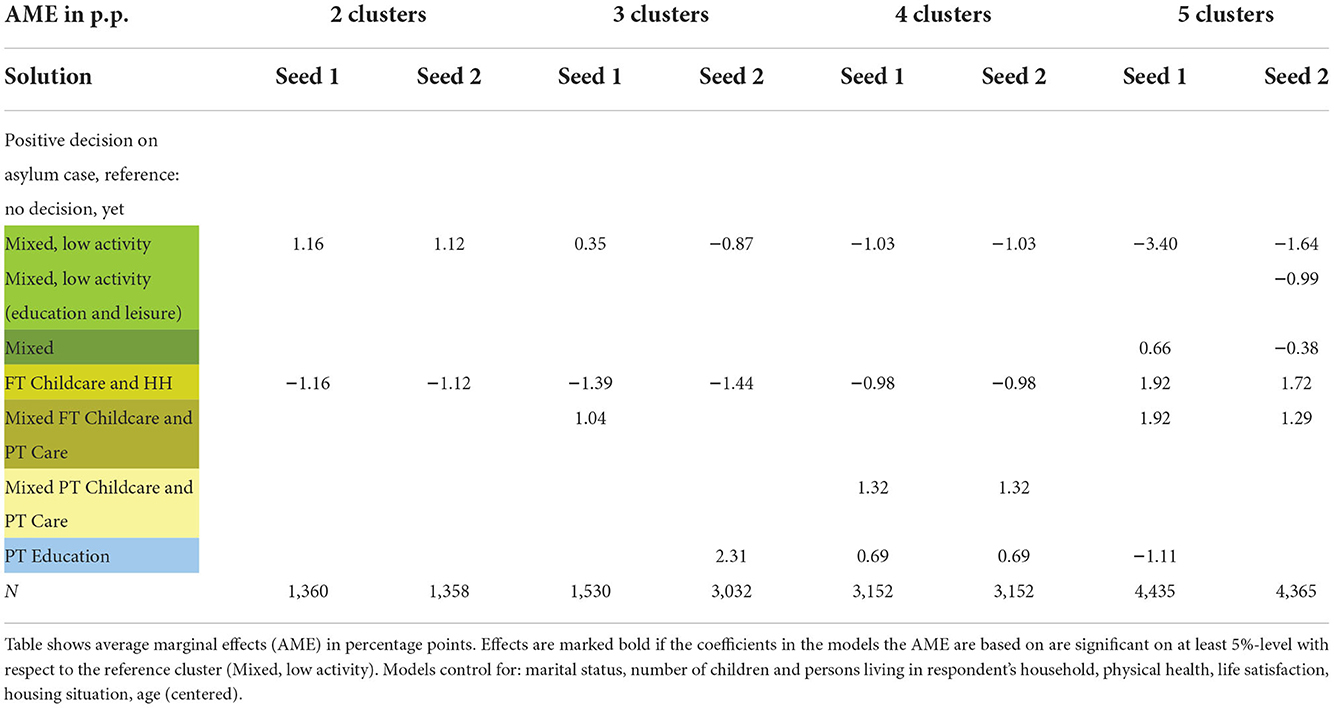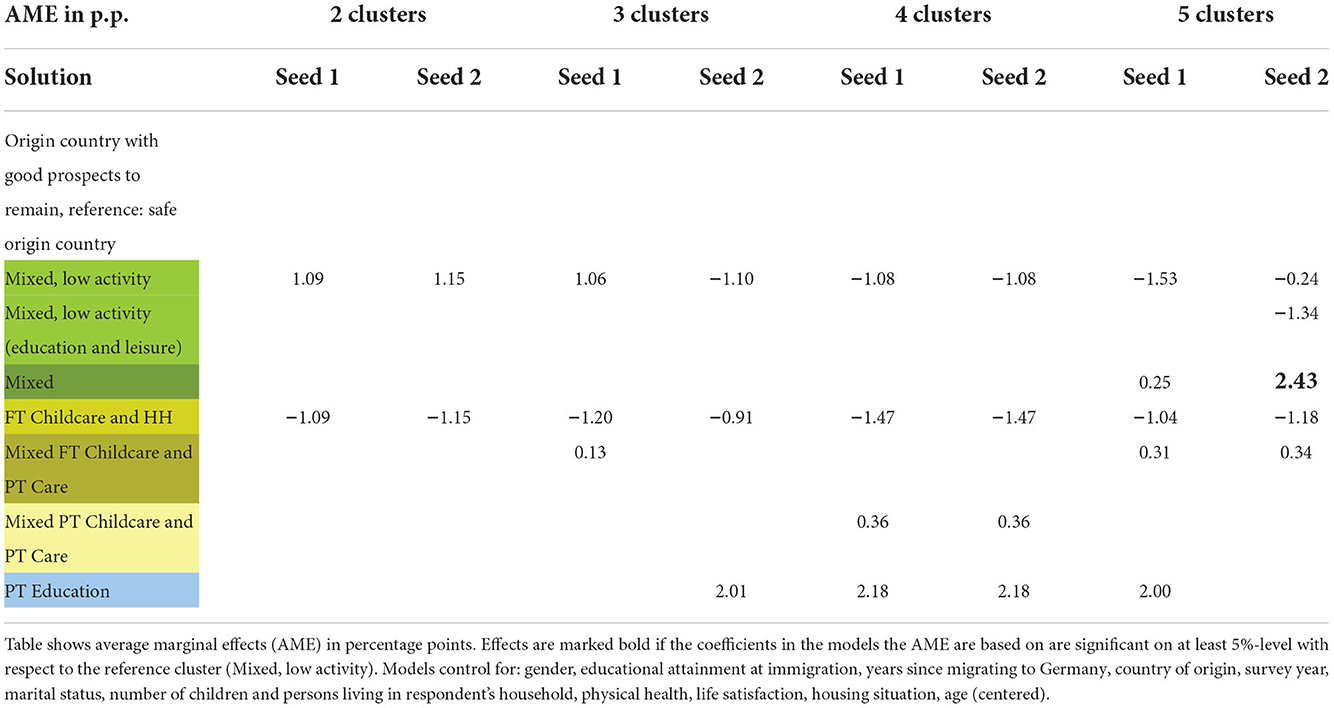- 1Mannheim Centre for European Social Research (MZES), University of Mannheim, Mannheim, Germany
- 2Graduate School of Economic and Social Sciences, Center for Doctoral Studies in Social and Behavioral Sciences, University of Mannheim, Mannheim, Germany
Introduction: Since the 2015/16 refugee influx to Germany and other European countries, these host societies have been challenged with the integration of culturally distant refugees. These recent arrivals can strategically invest their time in activities promoting their integration, thereby rendering time use as a channel of integration. Refugees are a vulnerable group that differs from other immigrants with respect to their migration motivation, experience, and conditions in the receiving countries. Accordingly, refugees might also differ from other immigrants with respect to their time use. This might play a role in explaining differences in refugees' and other immigrants' integration outcomes.
Methods: Using a cluster analysis approach, this contribution (1) descriptively examines whether and to what extent refugees' time use differs from that of other immigrants and the host-country population in Germany and (2) examines the role of refugees' legal status for their time use. The study examines time allocation to different activities of refugees, other first-generation immigrants, and native Germans, using data collected from 2016 to 2019 of the German Socio-Economic Panel, including the IAB-BAMF-SOEP Survey of Refugees and the IAB-SOEP Migration Sample.
Results and discussion: Results from (1) the cluster analysis approach show different clusters of time use patterns for the three population groups of refugees, other immigrants, and natives. For native Germans and other immigrants, the dominant time use cluster is characterized by full-time investment in employment activities. For refugees, the dominant time use pattern is characterized by low overall invested hours to the measured activities (low activity cluster). In contrast to the other two groups, a cluster of refugees predominantly allocating their time to employment activities is not found. Pooled analyses (2) of the role of refugees' legal status show some evidence that those who have a form of protection status, in comparison to those who have asylum seeker status, have a lower probability to display childcare- and household-related activities than to report low activity. However, fixed effects analyses show that refugees receiving a positive decision on their asylum application do not change with respect to their time use patterns.
Introduction
In 2015 and 2016, Germany and other OECD countries experienced a large influx of refugees seeking protection from war, persecution, and violence in their home countries (OECD/EU, 2018; Jaschke and Kosyakova, 2021). Refugees can be distinguished from other immigrant groups by the forced character of their migration (Echterhoff et al., 2020; Kogan and Kalter, 2020). Coming from destabilized countries (Kosyakova and Brücker, 2020), refugees do not have a perspective of returning to their home countries in the short-term (Brücker et al., 2020). The reasons for leaving their home countries make the group of refugees, who arrive in countries like Germany, a very selective one. Previous research has shown that refugees from the 2015/16 influx to Germany and other European countries are selective in so far that they have higher human capital and education than their counterparts who stayed in the home countries (Guichard, 2020; Aksoy and Poutvaara, 2021). Before and during their migration, many refugees experience trauma (Mansouri and Cauchi, 2007; Ambrosetti et al., 2021). This and the uncertainty and waiting in the asylum process of the host country lead to refugees' high post-migration stress (Ambrosetti et al., 2021). These factors of refugees' selectivity, their reasons for migration, their migration experience, and the restrictions they face in the asylum process in the host countries, distinguish refugees from other immigrant groups. More importantly, these factors restrict refugees in their opportunity and ability to integrate into the host society (Ambrosetti et al., 2021).
The integration of refugees and immigrants in general is a central goal of receiving societies and benefits these societies as well as the immigrants (Ager and Strang, 2008; Cheung and Phillimore, 2014). Integration is reflected in immigrants' participation in the labor market or in the educational system, in their housing and their health conditions in comparison to the native population of the host country (Ager and Strang, 2008). In short, integration describes the opportunity for immigrants to participate in life in the host country (Seidle and Joppke, 2012; Echterhoff et al., 2020). Immigrants can make active investments in their integration by strategically allocating time to activities that foster such integration in their everyday lives. This means that the allocation of time to activities on a regular everyday basis can be an indicator of immigrants' integration efforts. In addition, the resulting time use patterns themselves can be an indicator of integration, in so far that immigrants who display similar time use patterns as the members of the receiving society can be considered highly integrated into the host society. Integration via similarity in time use patterns mainly shows integration in terms of engagement in activities and habits, but I argue that the prioritization of investing time in some activities over others also reflects values and beliefs. For instance, the decision of immigrants to invest time in going to school in the host country reflects that they value education. Furthermore, the amount of time invested in this activity is an indicator of how much they value the activity. Investing 8 h a day in educational activities thereby reflects a higher value being placed on education than investing 3 h a day. Hence, the time use of immigrants, in terms of what activities time is invested in and how much of it, is an important indicator of integration that needs to be examined.
The time use of immigrants has rarely been studied as a whole and has rather been investigated in isolated activities. Most prominently, time investment in human capital accumulation, labor market activities, or housework has been examined (e.g., Cortes, 2004; Vargas and Chavez, 2010; Ribar, 2012). Previous research on the time use of refugees is mostly qualitative or looked at isolated activities as well (e.g., Cortes, 2004; Brekke, 2010). The goal of the present paper is to examine time use more holistically by describing it with a cluster analysis approach. This approach uses the time individuals allocated to different activities and generates clusters or groups of similar time use. These groups represent a categorization of time use patterns for the population in focus (refugees), which can be descriptively compared to the categorizations of time use patterns found for other populations (other immigrants and natives).
Given the differences between refugees and other immigrants as stated above, refugees' and other immigrants' time use is likely to differ. However, refugees' agency in time allocation, depending on the institutional restrictions in the host society, might further increase this difference. The present paper focuses on refugees in Germany, which is one of the European countries with the highest share of received asylum seekers from the 2015/16 influx (OECD, 2017), and therefore provides an ideal setting to study this heterogeneous group of refugees in the context of a European host society. Refugees face several institutional and legal barriers when first arriving in Germany. The amount of time since arriving in Germany and their legal status determine refugees' access to the labor market, their opportunity to move between municipalities as well as German federal states, and their financial situation. A positive decision on their asylum application lifts many of these barriers, which increases refugees' agency in time allocation and thereby increases their integration prospects into the host society. Hence, this paper (1) describes refugees' time use patterns and contrasts them with the time use patterns of other immigrants and the native German population. Additionally, it examines (2) the role of refugees' legal status for their time use by looking at how a refugee's time use changes after receiving a positive decision on their asylum application.
Theoretical considerations and previous research on time use
Time use
Time is a limited resource, and the choice of how to allocate it has implications for many areas of individuals' lives (Zerubavel, 1985). Allocating time to one activity means that one has less time available to allocate to other activities on each day, given that the day has a fix amount of 24 h. How one decides to spend this time is a product of external requirements (if one has a job, he/she is required to work a set amount of time), personal preferences (if one prefers to do sports rather than to take a language course, he/she invests time in sports), and other potential factors. In any case, allocating time to an activity serves a certain purpose, such as making money, trying to keep being healthy, or developing interpersonal relationships. This reasoning is in line with Becker's (1965) economic theory of the allocation of time, stating that individuals maximize their utility by allocating time to different activities. Depending on the individual and the context the individual lives in, utility takes different forms, such as income, productivity, or wellbeing (“psychic income”; Becker, 1965, p. 498). However, not only the composition of utility, in other words individuals' goals, but also the way of maximizing this utility differs between individuals in terms of how they allocate time to different activities to achieve these goals (Becker, 1965). The combination of goals that individuals want to reach, in other words their utility, and their strategy of reaching them therefore determines their overall time use patterns. While the goals that are leading time investment should differ based on individuals' characteristics and preferences, they are also likely to differ between the populations of refugees, other immigrants, and natives due to structural and systematic differences between them. Consequently, this would suggest differences in the time use patterns of the three populations.
The time use of refugees, other immigrants, and natives
In order to understand how refugees' time use might differ from other immigrants' and natives' time use, it is crucial to look at the systematic and structural differences between these groups of the population. Refugee migration is characterized by being forced due to war, violence, or persecution in the home country (Echterhoff et al., 2020; Kogan and Kalter, 2020). Their motivation to leave their home countries is not mainly driven by pull factors of the host countries, but rather by push factors of the country of origin (Borjas, 1987; Chiswick, 1999; Aksoy and Poutvaara, 2021). The process of migration of refugees itself is often dangerous and long (Echterhoff et al., 2020), where they have to rely on smugglers, suffer physical deprivation and harm, or experience other life-threatening situations and trauma on their way to the host countries (Mansouri and Cauchi, 2007; Gillespie et al., 2018; Alencar et al., 2019; Ambrosetti et al., 2021). Refugees come to the host country without a visa and have to apply for asylum before receiving legal status, whereas other immigrants apply for visas before migrating. This means that other immigrants know the legal conditions and preliminary duration of their stay in advance. In contrast, refugees cannot know the outcome of their asylum process and length of their stay when they arrive in the host country. After migrating, refugees might also be more prone to experiencing post-migration stress compared to other immigrants (Li et al., 2016). Post-migration stress is determined by factors like refugees' legal status, their housing situation, labor market access, and host-country language skills (Ambrosetti et al., 2021). Hence, in contrast to most other immigrants, refugees' migration motivation and migration process involve a lot of traumatic experiences that negatively affect their mental health (Mansouri and Cauchi, 2007; Lindert et al., 2009; Allsopp et al., 2014; Kogan and Kalter, 2020; Ambrosetti et al., 2021) and physical health (Allsopp et al., 2014; Jaschke and Kosyakova, 2021). These health issues are further amplified by the circumstances that refugees face in the host countries. Health issues affect refugees' everyday lives (Brücker et al., 2019) and make them more prone to having difficulties adapting to the host country compared to other immigrants. In addition, they might affect refugees' ability to use their time effectively, resulting in differences in the time use patterns of refugees and other immigrants (Expectation 1).
Due to the forced character of refugees' migration, they have little time to prepare for migrating to a host country in comparison to other immigrants. This means that refugees have less time to take language courses, make additional money for financial security, or invest in educational attainment that is transferable to the host country. Hence, refugees' human capital is less likely to be transferable to the host country compared to other immigrants' human capital (Brell et al., 2020; Kogan and Kalter, 2020), which poses incentives to invest time in host-country-specific human capital accumulation after migration to the host country. This can be explained with a rational choice approach to immigrants' human capital investment (Duleep and Regets, 1999), which expects investment in education rather than employment based on the transferability of skills and credentials acquired in the country of origin. An individual will invest in host-country education if opportunity costs are lower than the expected returns of the educational degree. This is the case if origin country-acquired human capital is not fully transferable to the host-country labor market. Furthermore, foreign education certificates, even if recognized in the host country, cannot fully close the gap to host country educational certificates in terms of employment probability (Damelang et al., 2020). This means that immigrants whose skills and educational credentials are less transferable to the host country are more inclined to invest in education compared to those whose credentials are fully transferable (Duleep and Regets, 1999). In addition, refugees expect to stay in the host countries longer since they have no short-term perspective of returning to their home countries (Kogan and Kalter, 2020), which further amplifies the expected returns of host-country specific human capital (Cortes, 2004). In combination with the young age of recently arrived refugees (in Germany, more than 60% of arrived refugees are between 20 and 35 years old; Brücker et al., 2020), these factors make the investment of time in education and training in the host country more likely for refugees compared to other immigrants (Expectation 2).
In contrast to all groups of first-generation immigrants, including refugees, individuals of the native population of the host country are brought up in the host country. This means they usually lack experience of migration, which includes issues surrounding transferability of human capital, visa applications and granting procedures, and host-country language acquisition. Hence, natives usually do not have to deal with any forms of post-migration stress and other migration-related issues, making them more equipped to allocate their time with their own agency and oriented toward a different form of utility compared to immigrants and refugees. Hence, I expect that refugees' time use differs from the time use of natives (Expectation 3).
Previous research examining the overall time use patterns of refugees is rare. A qualitative study by Brekke (2010) examining refugees in Sweden used information on their time allocation during a regular workday and found that refugees experience long periods each day without being engaged in a specific activity. These periods include staring out of windows or looking at themselves in the mirror (Brekke, 2010). Similarly, Dupont et al. (2005), who examined refugees in the Netherlands, found that they invest time in drug use in order to deal with their trauma and the long waiting periods in the asylum process.
Quantitative research on refugees' and other immigrants' time use focused on isolated activities. For instance, research on the labor market behavior of immigrants in various host countries has shown that during the first 5 years after migration, immigrant men allocate more time to paid labor and immigrant women more time to household work compared to natives (Vargas and Chavez, 2010; Ribar, 2012). Over time, their patterns became more similar to the native population (Vargas and Chavez, 2010; Ribar, 2012). Concerning refugees in particular, research showed that they are less likely to work compared to other immigrants (Cortes, 2004; Brell et al., 2020) and natives (Bratsberg et al., 2017; Bevelander and Luik, 2020) immediately after their arrival in the host country. But Cortes (2004) found that refugees make larger gains in working hours and income compared to economic immigrants in the 10 years since their arrival. Eventually, refugees surpass economic immigrants in terms of income and working hours. In the same 10-year interval, refugees also have higher rates of human capital accumulation in comparison to economic immigrants (Cortes, 2004).
Institutional background and legal barriers for refugees in Germany
As mentioned above, the initial circumstances that refugees face when arriving a new host country, mainly related to the asylum regulations, are an important factor distinguishing refugees from other immigrants. Upon arriving in the host country, refugees find themselves in a situation in which they have rather low control over their allocation of time due to legal restrictions. In the case of Germany, asylum seekers are directed to a reception facility, where they register and apply for asylum. They are assigned to an accommodation which they cannot leave without official permission (Residenzpflicht) and where they have to live during their first 6–18 months in Germany or until they receive an answer about their asylum application (BAMF, 2021). Asylum seekers can receive a positive decision on their asylum application in form of asylum, refugee protection, or subsidiary protection, if their application is not rejected due to their lacking entitlement to asylum (Kosyakova and Brenzel, 2020; BAMF, 2021). Each of these forms of protection come with a temporary residence permit and several rights. Among them are the opportunity to participate in integration and language courses as well as the permission to work in Germany (BAMF, 2021). This means that refugees gain more autonomy in the allocation of their time once they receive a positive decision on their asylum application. Refugees whose asylum application is rejected can receive a temporary suspension of deportation (Duldung). Similar to refugees who are still in the asylum process, those with a temporary suspension of deportation can enter the German labor market only after having received a permission to work from the authorities (BAMF, 2021).
Previous research on the effects of refugees' legal status on time use-related aspects has found that refugees who have a temporary residence permit are less likely to be employed compared to refugees who hold the citizenship of the host country, irrespective of their time spent in the host country (Bakker et al., 2014). Similarly, a lower likelihood to be employed in comparison to refugees with a citizenship status has been found for refugees with a permanent residence permit (Bakker et al., 2014). For Germany, Kosyakova and Brenzel (2020) found that refugees who have received a decision on their asylum application are faster in taking up employment and enrolling in language courses compared to those who have not yet received a decision. These findings suggest that receiving a decision on the asylum application fosters changes in time use in terms of investing time in educational and labor market activities.
When looking at refugees' legal status, it is also important to consider the country of origin. Asylum seekers from countries with good prospects to remain in the host country, meaning countries with more than 50% of asylum applications being accepted (BAMF, 2022b), can access language and integration courses even before receiving a positive decision about their asylum application (BAMF, 2017; Kosyakova and Brenzel, 2020). In addition, they only have a residence obligation (Residenzpflicht) within the first 3 months since their arrival in Germany (BAMF, 2021), which can be longer for refugees from save origin countries. The obligation to keep living in the federal state where they applied for asylum (Wohnsitzauflage) remains for all refugees, even after receiving legal protection status (BAMF, 2022a). Hence, for refugees with good prospects to remain, the decision on the asylum application should have less impact on their time use, since they have more autonomy even before the decision compared to refugees from other origin countries. Between the end of 2015 and the end of 2019, countries of origin with good prospects to remain were Eritrea, Iraq, Iran, Somalia, and Syria (Kosyakova and Brenzel, 2020).
Consequently, I expect to find that refugees' time use changes when they receive legal status (Expectation 4) and that this change in time use is less likely for refugees from countries with good prospects to remain in Germany compared to refugees from origin countries with lower prospects to remain in Germany (Expectation 5).
Data and analytic strategy
The focus of this paper lies on describing the time use of refugees in contrast to other immigrants and the native population in Germany, as well as assessing the role of refugees' legal status in their allocation of time. For this analysis, I rely on data from the German Socio-Economic Panel (Goebel et al., 2019; SOEP v36, 2021). The SOEP is a household panel starting in 1984 that randomly samples households in Germany and surveys all members of these households annually. The data also include a sample of refugees in form of the IAB-BAMF-SOEP Survey of Refugees (Kühne et al., 2019; IAB-BAMF-SOEP, 2021), which includes data from 2016 to 2019 of refugees who arrived in Germany between 2013 and 2016. The survey is conducted jointly by the Institute for Employment Research (IAB), the research data center of the German Federal Office for Migration and Refugees (BAMF), and the German Socio-Economic Panel (SOEP) at the German Institute for Economic Research (DIW). For information on other immigrants, I rely on the IAB-SOEP Migration Sample (Brücker et al., 2014; IAB-SOEP, 2021), which is a cooperation project between IAB and SOEP. Observations were pooled over waves from 2016 to 2019 and respondents between the age of 18 and 40 were considered, representing the young working age population in Germany with a more similar age structure to the refugee group (75% of refugee respondents were included in this age group). First-generation immigrants whose first interview was more than 6 years after immigration were excluded to make sure that refugees and other immigrants were observed in similar stages of living in Germany.
The data measured time use in a stylized way: every respondent indicated the number of hours that they allocated to a set of activities on a typical weekday. I used information for all activities that are available in the data for natives, immigrants, and refugees. These are employment, running errands, childcare, care and support for other persons, education/training, repairs and gardening, physical leisure activities and sports, leisure activities, and housework. I excluded all observations in which respondents did not receive one of the time use (sub-) questions, refused to answer, or gave an improbable answer for at least one of the activities. Hence, I coded time use in nine activities as the number of hours allocated to this activity, ranging from 0 to 24 allocated hours.
To construct the variable of interest, time use, I used k-means clustering to identify clusters of similar time allocation, whilst taking into account all nine activities as well as the number of hours allocated to the activities. The time use variables were standardized across all respondents used for the cluster analysis to ensure the equal influence of all activities for cluster assignment (Hastie et al., 2009, chap. 14.3.3). The k-means algorithm thereby randomly chose a number k of starting cluster centers, determined the closest cluster center for each observation, and assigned each observation to the cluster with its closest center (Hastie et al., 2009, chap. 14.3.6). To determine the closeness, Euclidean distance was used. In the next step, the initial cluster center in each cluster was replaced by the new cluster mean. This process was repeated until “within each cluster the average dissimilarity of the observations from the cluster mean, as defined by the points in that cluster, is minimized” (Hastie et al., 2009, p. 509). The resulting clusters depended on the starting values of the k centers (Makles, 2012); hence I estimated 20 rounds of clustering with different seeds for selection of the k starting centers with ks 1–15. Population groups were analyzed separately in samples of 16,022 native German, 12,316 refugee, and 2,013 immigrant observations.
The resulting clusters of time use were (1) analyzed descriptively and compared among the population groups. Further, (2) I assessed the role of refugees' asylum application status in a multinomial conditional fixed effects regression analysis. Here, I made use of the longitudinal structure of the data, looking at refugees only. The event in focus was receiving a positive decision on the asylum application. All waves after this positive decision were coded 1, while all waves before were coded 0. In addition, I estimated models with observations pooled over waves with multinomial logistic regressions, where legal status was coded as seven-category variable (1 = asylum seeker status, 2 = no permit, 3 = refugee or asylum status, 4 = subsidiary status or other humanitarian permit, 5 = Duldung (temporary suspension of deportation), 6 = permanent residence permit, 7 = other residence permit).
Analyses (2) took into account institutional factors (the time since arriving in Germany, country of origin, housing characteristics) and individual characteristics (age, marital status, number of persons and children in household, educational attainment at immigration, physical health, life satisfaction). The time since arriving in Germany was measured in years. Country of origin was grouped into nine categories [1 = Western countries (including Western Europe and Northern America as well as New Zealand and Australia), 2 = Eastern European countries, 3 = Middle Eastern countries (without Syria and Iraq), 4 = Asia (without Afghanistan; combined Central, East, South, and South East Asia mainly due to low numbers of observations for these regions), 5 = Latin America, 6 = Africa, 7 = Syria, 8 = Afghanistan, 9 = Iraq (these countries have sufficiently high numbers to be examined in separate categories)]. Housing characteristics were included in a dummy variable, which was 0 for living in a shared housing environment, such as refugee shelters or reception facilities, and 1 for living in private housing. Age was measured in years (centered), and marital status was measured dichotomously (0 not married, 1 married). I also included the number of persons and children living in the respondent's household. For education at immigration, I used an ordinal variable of education attained abroad with four categories (1 = compulsory school, no degree, 2 = compulsory school degree, 3 = secondary school degree, 4 = other school degree). Physical health was measured as subjective health reported on a 5-point scale from 1 “bad” to 5 “very good,” and life satisfaction as proxy for mental health was measured on a 11-point scale from 0 “completely dissatisfied” to 10 “completely satisfied.” The models also controlled for survey year. The analytical sample for analysis (2) included 9,780 refugee observations for the pooled models. The fixed effects analyses of refugees' legal status included between 1,358 and 4,435 observations, depending on the changes occurring in the dependent variable between waves.
Table 1 shows some of the descriptive statistics of the analytical sample of refugees in contrast to the samples of natives and other immigrants. The full descriptive tables can be found in the Supplementary Tables 1–3. The samples cut off observations below 18 and above 40 years, which was implemented in order to make the native and other immigrant samples more similar to the refugees in terms of their characteristics. This was successful in terms of age: the samples were rather balanced, all having a mean age of respondents around 30. Other imbalances between the samples remained. The refugee sample included more than 60% male observations, while the native and other immigrant samples were slightly female dominated. Refugees also tended to have more children in the household (almost two children in comparison to only one or less in the other samples). Among the refugee observations, the share of those only having primary education was more than 25 percentage points higher compared to the other samples. Refugees' health status on the other hand was very high (almost half of the refugee observations reported very good health). Concerning labor force status, the refugee sample included almost 22% of refugee observations in employment compared to 70% for other immigrants and 75% for natives. This is also reflected in the 19% of the refugee sample who reported at least 1 h spent in employment during a regular day. Of this share, the average hours reported to be spent in employment was 6.5 h. Further descriptive information on the allocation of hours to the different activities can be found in the Supplementary Tables 4–6. Refugees mostly came from origin countries in the Middle East (more than half were from Syria), while most other immigrants reported their origin to be in Western countries. Concerning their legal status, most observations in the refugee sample had asylum or refugee status (55.09%), with 19% of observations reporting asylum seeker status and around 14% reporting subsidiary protection status or another form of humanitarian protection. Over the four survey points from 2016 to 2019, the share of observations with asylum seeker residence permit declined, while the share of observations with asylum or refugee status and especially of those with subsidiary or other humanitarian status increased drastically. In 2019, <10% of the refugee sample had an asylum seeker status and over 80% had some form of protection status.
Results
The optimal number of clusters
In order to decide on the optimal number of clusters and to assess the stability of this number across different starting points of k, I estimated the proportional reduction of error coefficient (PRE) for each round of clustering. This measure estimates the reduction in the within cluster sum of squares of each round proportional to the previous round (Makles, 2012). Figure 1 shows the optimal number of clusters for the different rounds of clustering by population group, suggested by the PRE. The size of the circles represents the frequency with which the numbers occurred as optimum. Figure 1A on the left shows the one best solution for each clustering round and displays a concentration around the lower numbers of optimal clusters. Given that the PRE of the one best solution per round of clustering is often very similar to the second best and further solutions, I rely on the results from Figure 1B on the right. This graph shows the four best solutions for the number of clusters for each round. Here, we can see more spread in the suggested optimal number of clusters, but still the highest concentration among the numbers between two and five. Hence, the cluster analysis was conducted for ks of two, three, four, and five clusters by population group, using the same seed per k for each population group. Additionally, in order to look at the stability of the resulting clusters across different seeds, the cluster analysis was conducted twice for each number of clusters and population group.
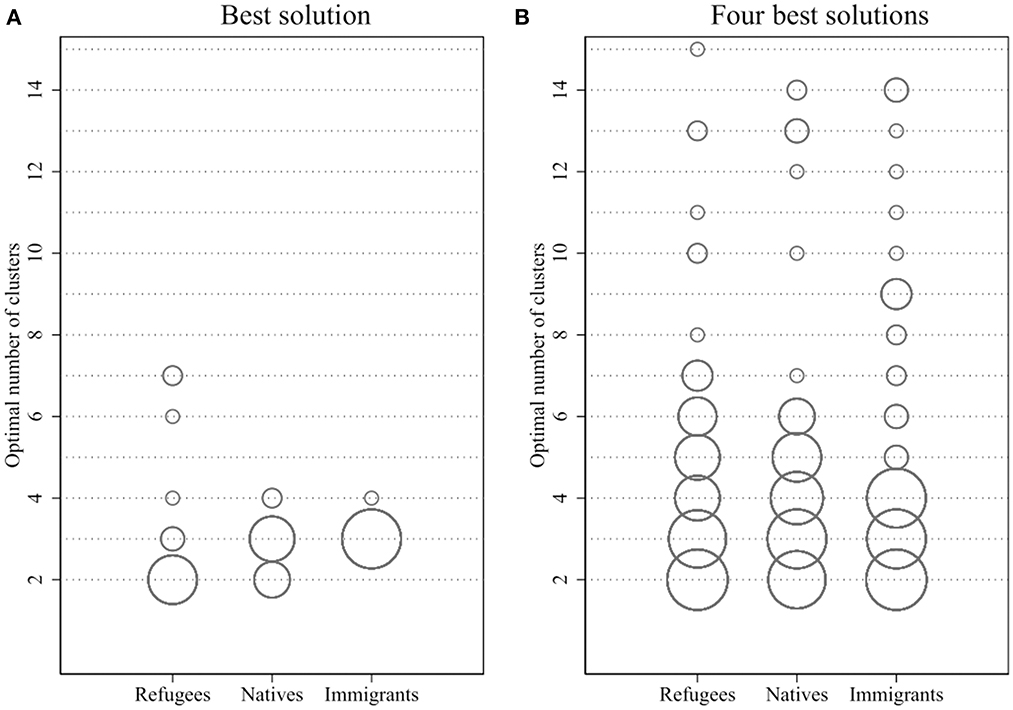
Figure 1. Optimal number of clusters by population group. Circle size represents frequency, with larger circles representing higher frequency. (A) Best solution. (B) Four best solutions.
Time use patterns
I descriptively examined the resulting clusters in terms of the average investment of hours in each activity by cluster. Based on these descriptive statistics, the clusters were labeled according to their main activity, i.e., the activity to which the most hours were allocated. If a cluster was characterized by two or more activities with similar amounts of invested time (<2 h difference), this is reflected in the cluster name by the prefix mixed. I also distinguished between full-time, when the main activity was allocated at least 7 h, and part-time, when the main activity was allocated between 4 and 7 h. Clusters were labeled with low activity if the overall hours reported by the respondents in the cluster was on average <10 per day. Tables 2–4 show these descriptive statistics and labels for both seeds of the five-cluster solutions for refugees, natives, and immigrants, in order to exemplify how the labeling was done.
In order to compare the time use patterns of refugees, other immigrants, and natives, the labeling was done for all performed cluster analyses according to the rules above. Figures 2–4 show the resulting cluster labels by k and the used seed, sorted by cluster size (Figure 2 for refugees, Figure 3 for natives, Figure 4 for other immigrants). For refugees, across different numbers of k clusters, I consistently found the largest cluster to be characterized by low activity, meaning <10 h overall reported by the respondents in this cluster. Secondly, I consistently found a cluster characterized by time investment in childcare and household activities. Other time use clusters were only found for larger ks and were either characterized by investment in education or also in childcare and care activities.
When comparing the patterns of time use clusters, one can see differences between the patterns of natives and immigrants in comparison to the refugees. Natives and other immigrants were consistently grouped into a large cluster of respondents investing time in employment. Only after this largest cluster did natives and other immigrants display similarities with the time use of refugees. For the group of other immigrants, the second largest cluster was characterized by time investment in childcare and household, similarly as for refugees. I also found some mixed clusters for other immigrants when looking at larger ks, meaning that in these clusters, there was no clear main activity. Such clusters are also found for refugees. For natives, on the other hand, the cluster analyses found no consistent second largest cluster. Instead, the clusters were overall very similar to each other in the sense that there was always a rather large time investment in employment, see e.g., the clusters full-time employment and other activities or mixed part-time leisure and part-time employment. Like refugees, however, natives displayed a cluster characterized by investment in education, which was only found once in all cluster solutions for other immigrants. A childcare cluster for natives was only displayed for k larger than two, but it was consistently among the smallest clusters. Overall, when looking at the clusters that the k-means clustering algorithm found for different numbers of k, the clusters were rather consistent across different ks and across different seeds within the population groups. However, the clusters were very different across the population groups, meaning that refugees, other immigrants, and natives seemed to invest their time differently.
Since these results still show some similarities across the population groups, I examined the distribution of the respondents across the clusters in an additional step. Figure 5 shows these distributions in percent, with clusters again being sorted by size. The percentages of respondents in similar clusters were similar across populations groups. Natives' and other immigrants' largest cluster of full-time employment was similar in relative size for the same k. Refugees' and other immigrants' full-time childcare and household and full-time childcare clusters only had up to a 4-percentage point difference in size for the same k. For refugees' and natives' part-time education cluster, this difference was even smaller with one percentage point. One difference between the distributions was very striking: natives' childcare-related clusters (full-time childcare) were only about half the size of the childcare-related clusters of refugees and other immigrants (full-time childcare and household, full-time childcare). Overall, it is important to note that the analyses showed some similarities between the time use of refugees, other immigrants, and natives, but the three groups never displayed the same clusters for the same k. Hence, these results are in line with Expectations 1 and 3, that refugees' time use differs from the time use of other immigrants and natives. In addition, I rather consistently find a cluster of time investment in education for larger ks for refugees, but only once for other immigrants. Furthermore, this education cluster of other immigrants is much smaller than the ones found for refugees. This is in line with Expectation 2, stating that refugees are more likely to invest time in education in the host country than other immigrants.
Heterogeneity in time use patterns—Descriptive analyses
As for the heterogeneity in time use patterns within population groups, several interesting findings emerged. An examination of how immigrants' migration motivation was associated with cluster membership showed that economic immigrants were significantly more likely to sort into the employment clusters compared to family immigrants. This was consistently around 6–11 percentage points for all k cluster solutions. However, family immigrants were not always significantly more likely to sort into the childcare-oriented clusters compared to economic immigrants. For natives, a gender analysis showed that women were significantly more likely to sort into the full-time employment cluster than men, if the clustering algorithm also detected a cluster of full-time employment and other activities, which was much more likely to be sorted into by men (more than 15 percentage points more than women). For both analyses, results can be found in Supplementary Tables 7, 8.
Refugees, in comparison to the other two samples had on average about 0.5 to one child more in the household. Furthermore, 64% of the refugee sample reported at least one child in the household (43% for natives), which might have driven the large childcare-oriented clusters. Indeed, looking at the percentage of refugee observations without children in the household by cluster, showed that in the clusters involving childcare, shares of observations without children were small (between 0.31 and 4.06%). Accordingly, in the refugee clusters that do not involve childcare, the shares of observations without children were higher. For instance, in the part-time education cluster the share of observations without children in the household was around 24% (see Supplementary Table 9). However, the consistently largest cluster of low activity, which comprised between 40 and 70% of the refugee sample overall, included between 70 and 97% of observations without children in the household for most ks. This suggests that separate analyses for refugees without children in the household would likely yield very small childcare and care clusters, but still very large low activity clusters.
Refugees' cluster membership by country of origin showed that refugees from African, Asian, and Eastern European countries were represented with the highest shares in the low activity clusters amongst all refugee groups. The childcare-oriented clusters included high shares of refugees from Eastern European countries. Lastly, the education-oriented cluster: Refugees from the Middle Eastern countries had the highest share in this cluster (21% of this group belonged to the education-oriented cluster). The shares of Syrian, Afghan, Iraqi, and African refugees in this cluster, however, were also rather high with around 16% (see Supplementary Table 10).
Heterogeneity in refugees' time use patterns—Refugees' legal status
The role of refugees' legal status for their time use patterns was examined in two ways. First, I used pooled multinomial logistic regression models for each cluster solution. Interestingly, for all numbers of clusters, results indicated that respondents with refugee or asylum status, or subsidiary protection or other humanitarian status, were rather consistently significantly more likely to sort into the mixed and low activity clusters compared to the full-time childcare and household cluster. Effect sizes were around 2–4 percentage points. Having a permanent residence permit showed a significant effect only in some models: respondents with a permanent residence permit were significantly more likely to sort into the education- and care-related clusters compared to the low activity clusters. Here, effect sizes were even larger with around 10 percentage points. However, in most models these effects were not significant. As example, Table 5 shows the effects for the three cluster solutions. The solutions for the other clusters can be found in the Supplementary Tables 12–15.
Second, I used the longitudinal structure of the data with multinomial logistic conditional fixed effects models, which estimated the effect of receiving a positive decision on the asylum application on sorting into the different clusters. These models found only very small and insignificant changes in the probability to sort into different clusters when the respondents received their positive decision (see Table 6). Hence, refugees do not seem to drastically change their time allocation to the measured activities once they receive their legal asylum status, at least in the short term (not in line with Expectation 4).
Additional sensitivity analyses showed similar results when only looking at refugees from countries of origin with good prospects to remain in Germany (between 2015 and 2019, countries of origin with good prospects to remain were Eritrea, Iraq, Iran, Somalia, and Syria). On the other hand, for fixed-effects analyses on the group of refugees without good prospects to remain, case numbers were too low. For these refugees, receiving legal asylum should result in the most changes within their lives compared to refugees with good prospects to remain, who have some privileges before receiving a legal status such as access to integration courses. In order to address potential differences between refugees with and without good prospects to remain in Germany, additional analyses on the pooled refugee sample were conducted. These analyses looked at the effect of being from an origin country with good prospects to remain on sorting into the different time use clusters. In Table 7, the results of this analysis show overall rather small and insignificant effects. This shows that refugees from origin countries with and without good prospects to remain in Germany largely do not differ in terms of their time use, irrespective of their legal status (not in line with Expectation 5).
Discussion
The time use of refugees has rarely been quantitatively studied by looking at more than one activity. The present study looks at refugees' time use in a more holistic way and explores the differences in time use of refugees, other immigrants, and natives in Germany. The use of time is an active investment in integration for refugees and other immigrants and hence, a difference in time use between these two groups might contribute to understanding differences in integration outcomes. Indeed, the present study found differences in the time use patterns of refugees, other immigrants, and natives. Members of the majority German population and other immigrants seemed to be more likely to invest time in employment, whereas refugees formed large clusters of either childcare or low activity. However, there were clusters of refugees' time use that were also found for the other two groups. Immigrants also displayed large clusters of time investment in childcare-oriented activities, whereas natives displayed clusters of time investment in education, just like refugees. Overall, even though there were some similar time use clusters, the exact same time use clusters for same k and seed for all three population groups were never found. This is in line with Expectations 1 and 3 stating that the time use of refugees differs from the time use of other immigrants and natives in Germany. In addition, in line with Expectation 2, refugees' time use patterns showed a group that invests time in education, which was not found for other immigrants.
This difference of refugees' time use from the time use of other immigrants and natives was mostly driven by refugees' low time investment in employment. Even though almost 20% of the refugee sample reported a time investment of at least 1 h in employment activities, this did not lead to the formation of an employment cluster. One reason for this is that the other activities were much more important for the cluster formation among the refugee sample since they were more consistently invested in by all respondents in the sample, meaning that the share of respondents who invested time in these activities was higher. Employment was among the three activities with the lowest share of observations investing time in this activity for refugees. In contrast for natives, employment was the activity with the third highest share of observations who invest time in this activity, with only 6 percentage points difference to the activity with the highest share. This is similar for the immigrant sample (detailed information can be found in Supplementary Tables 4–6).
The second factor that drove clustering in the refugee sample is the high share of those who reported only few hours in the surveyed activities overall. In the refugee sample, 43% of observations reported <10 h of activities, while this share was much lower for natives (7%) and for other immigrants (10%). Since the analysis is limited to the information on time spent in the measured activities, it neglects potential other activities. This is especially problematic if refugees were to allocate more of their time to such unmeasured activities (rather than being really inactive) compared to the other population groups, because it makes comparing the groups more difficult. For instance, previous qualitative research suggests that some refugees spent time volunteering and helping other refugees (Kallio et al., 2021; Lubit, 2022). Activities such as this are not captured in the data. Another activity not captured in the data but likely important for refugees is job search effort. A short descriptive analysis of the shares of refugee observations out of labor force and registered as unemployed by cluster, showed that indeed the low activity and the mixed clusters consistently show higher shares of observations that are registered as unemployed (proxying looking for a job) than of observations out of labor force (proxying not employed but also not looking for work). For the other clusters, this difference in shares was either the opposite or there was no difference in shares (see Supplementary Table 11). This suggests that at least some of the observations sorted into the low activity clusters because actively looking for work was not captured in the data. Similarly, the measurement of the education-related activities might result in differences between refugees and the other population groups. Since more than 70% of the refugee observations in the sample have been enrolled in some form of integration or language course, more could have reported to invest time in education than the 23% who did report it. This might be due to the refugee respondents not counting their participation in the language classes as educational activity, which would additionally increase the sorting of refugee observations into the low activity clusters.
However, even if both the additional measuring of other activities and the use of a different method to look at time use patterns would lead to refugees' time use clusters looking different than in the present study, the clusters of refugees' time use would still likely not be similar to the time use clusters of natives and other immigrants. Instead, they would likely form additional clusters of job searching activities, volunteering activities, or similar activities, which in turn would not be found in the same size for natives and other immigrants. Hence, the difference in time use patterns would prevail.
This difference in time use patterns between refugees and other immigrants should have important implications for their integration outcomes. The deliberate and strategic investment of time in certain activities that foster integration will affect integration outcomes and, in addition, the time use patterns of an immigrant or refugee becoming more similar to the patterns of the native population is an indicator of integration itself. For instance, if we deem time investment in employment to foster integration, then refugees would lag behind other immigrants at least in the first years since their arrival in the host country. Similarly, given that refugees' time use clusters are more different from the natives' compared to the other immigrants' clusters, the similarity of time use patterns as indicator of integration would also suggest that refugees lag behind other immigrants in terms of integration. As discussed, multiple differences between refugees and other immigrants, such as migration motivation and experience, make such differences in time use patterns likely. Especially the conditions in the host country that come with many legal barriers for refugees should play a role for time use patterns.
Indeed, my analyses showed that having asylum or refugee status as well as subsidiary protection or other humanitarian status was associated with a lower probability to sort into the childcare- and household-oriented cluster in comparison to the low activity cluster. On the other hand, the fixed effects analyses looking at the effect of receiving a positive decision on the refugees' asylum cases for their time use found insignificant and small effects (no support for Expectation 4). Since receiving legal asylum lifts many of the institutional restrictions which refugees face in the host society, their time allocation after reception should be much more free than before, meaning that they potentially have more similar agency in their time allocation than natives and other immigrants. However, the results suggest that it might be difficult for refugees to change their time use and their situation immediately after receiving their legal status. Kosyakova and Brenzel (2020) reported that refugees in 2017 in Germany had waited on average 6 months for a positive decision on their asylum application. This means 6 months of living without a legal status and the restrictions that come with this situation. In addition, these refugees took up their first employment in Germany on average 20 months after applying for asylum (Kosyakova and Brenzel, 2020), suggesting that refugees need time to adjust to the host country, find a job, and learn the German language, even after they receive their legal status. Hence, the period of 4 years that I examined in this paper, of which the first observed year had to be without legal status in the fixed effects models, might be too short to observe meaningful changes in the time use of refugees. In addition, over 50% of the refugee sample were from Syria meaning they had good prospects to remain in Germany, which comes with fewer restrictions even before gaining legal status. With Expectation 5, I argued that refugees from such countries with good prospects to remain should be less likely to show a change in time use when receiving legal status since there were fewer restrictions lifted with it. However, my analyses showed that refugees from countries with and without good prospects to remain largely showed no difference in time use, and hence, Expectation 5 was not supported.
The study's drawbacks mostly concern the data. They measure time use in a stylized way, yet it would be preferable to have time use diaries in which respondents chronologically report the hours spent doing certain activities throughout the course of a day. Such data can be used to study time use sequences, which would be useful to get a holistic view of the time allocation per day. Hence, the use of unordered time information is only an approximation of what a usual day in a refugee's life looks like. In addition, the lack of measurement of other activities, which are potentially more relevant for the group of refugees, prevents the analysis from more accurately and holistically describing the time use of all three population groups. Further research is therefore needed to more deeply investigate the differences in the time use of refugees, other immigrants, and natives, as well as its predictors such as legal status or individual characteristics. Furthermore, it is necessary to explicitly study the implications of differences in time use for integration outcomes and time use patterns as indicator of integration. This would further the understanding of the factors holding back refugee integration and the development of measures to eliminate such factors in order to facilitate the integration of refugees.
Data availability statement
Publicly available datasets were analyzed in this study. This data can be found here: SOEP Research Data Center: https://www.diw.de/en/diw_01.c.601584.en/data_access.html.
Ethics statement
Ethical review and approval was not required for the study on human participants in accordance with the local legislation and institutional requirements. Written informed consent for participation was not required for this study in accordance with the national legislation and the institutional requirements.
Author contributions
JK developed the concept and design of the study, performed all data preparation and statistical analyses, wrote all drafts of the manuscript, and revised and approved the submitted manuscript version.
Funding
This work was supported by the University of Mannheim's Graduate School of Economic and Social Sciences, and the European Research Council (ERC) under the European Union's Horizon 2020 research and innovation programme (Grant agreement No. 864683). The publication of this article was funded by the University of Mannheim.
Conflict of interest
The author declares that the research was conducted in the absence of any commercial or financial relationships that could be construed as a potential conflict of interest.
Publisher's note
All claims expressed in this article are solely those of the authors and do not necessarily represent those of their affiliated organizations, or those of the publisher, the editors and the reviewers. Any product that may be evaluated in this article, or claim that may be made by its manufacturer, is not guaranteed or endorsed by the publisher.
Supplementary material
The Supplementary Material for this article can be found online at: https://www.frontiersin.org/articles/10.3389/fhumd.2022.1037778/full#supplementary-material
References
Ager, A., and Strang, A. (2008). Understanding integration: a conceptual framework. J. Refug. Stud. 21, 166–191. doi: 10.1093/jrs/fen016
Aksoy, C. G., and Poutvaara, P. (2021). Refugees' and irregular migrants' self-selection into Europe. J. Dev. Econ. 152, 102681. doi: 10.1016/j.jdeveco.2021.102681
Alencar, A., Kondova, K., and Ribbens, W. (2019). The smartphone as a lifeline: an exploration of refugees' use of mobile communication technologies during their flight. Media Cult. Soc. 41, 828–844. doi: 10.1177/0163443718813486
Allsopp, J., Sigona, N., and Phillimore, J. (2014). Poverty Among Refugees and Asylum Seekers in the UK. Working Paper 1/2014. IRIS Working Paper Series. Birmingham: Intsitute of Research into Superdiversity, University of Birmingham.
Ambrosetti, E., Dietrich, H., Kosyakova, Y., and Patzina, A. (2021). The impact of pre- and postarrival mechanisms on self-rated health and life satisfaction among refugees in Germany. Front. Sociol. 6, 1–17. doi: 10.3389/fsoc.2021.693518
Bakker, L., Dagevos, J., and Engbersen, G. (2014). The importance of resources and security in the socio-economic integration of refugees. A study on the impact of length of stay in asylum accommodation and residence status on socio-economic integration for the four largest refugee groups in the Netherlands. J. Int. Migr. Integr. 15, 431–448. doi: 10.1007/s12134-013-0296-2
BAMF (2017). Das Bundesamt in Zahlen 2016. Asyl, Migration Und Integration [The Federal Office in Numbers 2016. Asylum, Migration, and Integration]. Report. Nuremberg: Bundesamt für Migration und Flüchtlinge [Federal Office for Migration and Refugees].
BAMF (2021). The Stages of the German Asylum Procedure. An Overview of the Individual Procedural Steps and the Legal Basis. Nuremberg: Bundesamt für Migration und Flüchtlinge [Federal Office for Migration and Refugees].
BAMF (2022a). Steht Die Wohnsitzauflage Einer Arbeitsaufnahme Entgegen? [Does the Residence Obligation Contradict Taking up Employment?]. Bundesamt Für Migration Und Flüchtlinge [Federal Office for Migration and Refugees]. Available online at: https://www.bamf.de/SharedDocs/FAQ/DE/ZugangArbeitFluechtlinge/011-wohnsitzauflage-arbeitsaufnahme.html?nn=282388 (accessed October 25, 2022).
BAMF (2022b). Was heißt gute Bleibeperspektive? [What does good prospects to remain mean?]. Bundesamt für Migration und Flüchtlinge [Federal Office for Migration and Refugees]. (2022). https://www.bamf.de/SharedDocs/FAQ/DE/IntegrationskurseAsylbewerber/001-bleibeperspektive.html?nn=282388 (accessed April 14, 2022).
Becker, G. S. (1965). A theory of the allocation of time. Econ. J. 75, 493–517. doi: 10.2307/2228949
Bevelander, P., and Luik, M. A. (2020). Refugee employment integration heterogeneity in sweden: evidence from a cohort analysis. Front. Sociol. 5, 44. doi: 10.3389/fsoc.2020.00044
Borjas, G. J. (1987). Self-selection and the earnings of immigrants. Am. Econ. Rev. 77 (4): 531–553. doi: 10.3386/w2248
Bratsberg, B., Raaum, O., and Roed, K. (2017). Immigrant Labor Market Integration across Admission Classes. Working Paper 10513. IZA Discussion Papers. Bonn: IZA—Institute of Labor Economics. doi: 10.2139/ssrn.2911451
Brekke, J.-P. (2010). Life on hold: the impact of time on young asylum seekers waiting for a decision. Discourse. J. Childhood Adolesc. Res. 5, 159–167. Available online at: https://nbn-resolving.org/urn:nbn:de:0168-ssoar-354603
Brell, C., Dustmann, C., and Preston, I. (2020). The labor market integration of refugee migrants in high-income countries. J. Econ. Perspect. 34, 94–121. doi: 10.1257/jep.34.1.94
Brücker, H., Croisier, J., Kosyakova, Y., Kröger, H., Pietrantuono, G., Rother, N., et al. (2019). Second Wave of the IAB-BAMF-SOEP Survey: Language Skills and Employment Rate of Refugees Improving with Time. IAB-Kurzbericht. Nuremberg: Institute for Employment Research (IAB).
Brücker, H., Kosyakova, Y., and Vallizadeh, E. (2020). Has there been a “refugee crisis”? New insights on the recent refugee arrivals in Germany and their integration prospects. Soziale Welt 71, 24–53. doi: 10.5771/0038-6073-2020-1-2-24
Brücker, H., Kroh, M., Bartsch, S., Goebel, J., Kühne, S., Liebau, E., et al. (2014). The New IAB-SOEP Migration Sample: An Introduction into the Methodology and the Contents. 216. SOEP Survey Papers, Series C. Berlin/Nuremberg: German Institute for Economic Research DIW.
Cheung, S. Y., and Phillimore, J. (2014). Refugees, social capital, and labour market integration in the UK. Sociology 48, 518–536. doi: 10.1177/0038038513491467
Chiswick, B. R. (1999). Are immigrants favorably self-selected? Am. Econ. Rev. 89, 181–85. doi: 10.1257/aer.89.2.181
Cortes, K. E. (2004). Are refugees different from economic immigrants? Some empirical evidence on the heterogeneity of immigrant groups in the United States. Rev. Econ. Stat. 86, 465–480. doi: 10.1162/003465304323031058
Damelang, A., Ebensperger, S., and Stumpf, F. (2020). Foreign credential recognition and immigrants' chances of being hired for skilled jobs—evidence from a survey experiment among employers. Social Forces 99, 648–671. doi: 10.1093/sf/soz154
Duleep, H. O., and Regets, M. C. (1999). Immigrants and human-capital investment. Am. Econ. Rev. 89, 186–191. doi: 10.1257/aer.89.2.186
Dupont, H. J., Kaplan, C. D., Verbraeck, H. T., Braam, R. V., and Van de Wijngaart, G. F. (2005). Killing time: drug and alcohol problems among asylum seekers in the Netherlands. Int. J. Drug Policy 16, 27–36. doi: 10.1016/j.drugpo.2004.06.002
Echterhoff, G., Hellmann, J. H., Back, M. D., Kärtner, J., Morina, N., and Hertel, G. (2020). Psychological antecedents of refugee integration (PARI). Perspect. Psychol. Sci. 15, 856–879. doi: 10.1177/1745691619898838
Gillespie, M., Osseiran, S., and Cheesman, M. (2018). Syrian refugees and the digital passage to europe: smartphone infrastructures and affordances. Social Med. Soc. 4, 1–12. doi: 10.1177/2056305118764440
Goebel, J., Grabka, M. M., Liebig, S., Kroh, M., Richter, D., Schröder, C., et al. (2019). The German socio-economic panel (SOEP). J. Econ. Stat. 239, 345–360. doi: 10.1515/jbnst-2018-0022
Guichard, L. (2020). Self-selection of asylum seekers: evidence from Germany. Demography 57, 1089–1116. doi: 10.1007/s13524-020-00873-9
Hastie, T., Tibshirani, R., and Friedman, J. (2009). The Elements of Statistical Learning: Data Mining, Inference, and Prediction. 2nd Edition. Springer Series in Statistics. New York: New York: Springer.
Jaschke, P., and Kosyakova, Y. (2021). Does facilitated and early access to the healthcare system improve refugees' health outcomes? Evidence from a natural experiment in Germany. Int. Migr. Rev. 2021, 1–31. doi: 10.1177/0197918320980413
Kallio, K. P., Meier, I., and Häkli, J. (2021). Radical hope in asylum seeking: political agency beyond linear temporality. J. Ethn. Migr. Stud. 47, 4006–4022. doi: 10.1080/1369183X.2020.1764344
Kogan, I., and Kalter, F. (2020). An empirical-analytical approach to the study of recent refugee migrants in Germany. Soziale Welt 71, 3–23. doi: 10.5771/0038-6073-2020-1-2-3
Kosyakova, Y., and Brenzel, H. (2020). The role of length of asylum procedure and legal status in the labour market integration of refugees in Germany. Soziale Welt 71, 123–159. doi: 10.5771/0038-6073-2020-1-2-123
Kosyakova, Y., and Brücker, H. (2020). Seeking asylum in Germany: do human and social capital determine the outcome of asylum procedures? Eur. Sociol. Rev. 36, 663–683. doi: 10.1093/esr/jcaa013
Kühne, S., Jacobsen, J., and Kroh, M. (2019). Sampling in Times of High Immigration: The Survey Process of the IAB-BAMF-SOEP Survey of Refugees. Available online at: https://surveyinsights.org/?p=11416 (accessed November 19, 2022).
Li, S. S., Liddell, B. J., and Nickerson, A. (2016). The relationship between post-migration stress and psychological disorders in refugees and asylum seekers. Curr. Psychiatry Rep. 18, 1–9. doi: 10.1007/s11920-016-0723-0
Lindert, J., von Ehrenstein, O. S., Priebe, S., Mielck, A., and Brähler, E. (2009). Depression and anxiety in labor migrants and refugees: a systematic review and meta-analysis. Soc. Sci. Med. 69, 246–257. doi: 10.1016/j.socscimed.2009.04.032
Lubit, A. J. (2022). A mother's experience of asylum: conflicting temporalities, belongng, and evolving care relations. J. Intercult. Stud. 43, 464–479. doi: 10.1080/07256868.2022.2086226
Makles, A. (2012). Stata tip 110: how to get the optimal k-means cluster solution. Stata J. 12, 347–351. doi: 10.1177/1536867X1201200213
Mansouri, F., and Cauchi, S. (2007). A psychological perspective on Australia's asylum policies. Int. Migr. 45, 123–150. doi: 10.1111/j.1468-2435.2007.00398.x
OECD (2017). Finding Their Way: The Labour Market Integration of Refugees in Germany. OECD, International Migration Division, Directorate for Employment, Labour and Social Affairs.
OECD/EU (2018). Settling in 2018: Indicators of Immigrant Integration. Paris, Brussels: OECD Publishing and European Union. doi: 10.1787/9789264307216-en
Ribar, D. C. (2012). Immigrants' Time Use: A Survey of Methods and Evidence. Working Paper 6931. IZA Discussion Papers. Bonn: IZA—Institute of Labor Economics.
Seidle, F. L., and Joppke, C. (2012). “Introduction,” in Immigrant Integration in Federal Countries, ed. C. Joppke and F. Leslie Seidle. Montreal, Canada: Montreal, Canada: McGill-Queen's University Press, 3–22.
SOEP v36 (2021). Socio-Economic Panel (SOEP), Version 36, Data from Years 1984-2019 (SOEP Core V36, EU-Edition). SOEP v36.
Vargas, A. J., and Chavez, M. (2010). Assimilation Effects Beyond the Labor Market: Time Allocations of Mexican Immigrants to the US. Lubbock: Texas Tech University.
Keywords: refugees, time use, cluster analysis, migration, integration
Citation: Kuhlemann J (2022) Refugees' time investments—Differences in the time use of refugees, other immigrants, and natives in Germany. Front. Hum. Dyn. 4:1037778. doi: 10.3389/fhumd.2022.1037778
Received: 06 September 2022; Accepted: 22 November 2022;
Published: 16 December 2022.
Edited by:
Agnieszka Kanas, Erasmus University Rotterdam, NetherlandsReviewed by:
Philipp Jaschke, Institute for Employment Research (IAB), GermanyVerena Seibel, Utrecht University, Netherlands
Copyright © 2022 Kuhlemann. This is an open-access article distributed under the terms of the Creative Commons Attribution License (CC BY). The use, distribution or reproduction in other forums is permitted, provided the original author(s) and the copyright owner(s) are credited and that the original publication in this journal is cited, in accordance with accepted academic practice. No use, distribution or reproduction is permitted which does not comply with these terms.
*Correspondence: Jana Kuhlemann, jana.kuhlemann@mzes.uni-mannheim.de
 Jana Kuhlemann
Jana Kuhlemann